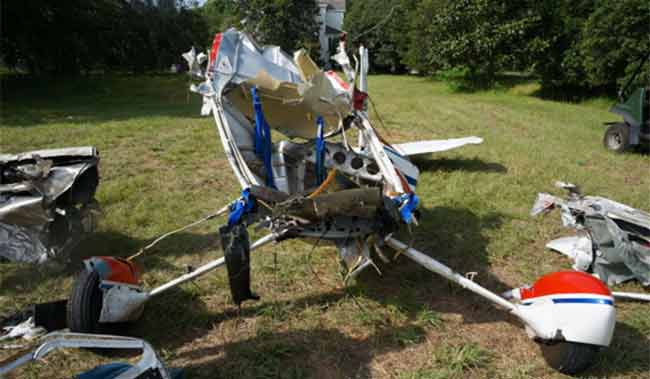
The U.S. government has taken responsibility for the July 2015 midair collision between a U.S. Air Force F-16 and a Cessna 150 that killed two people. NTSB
In taking responsibility for the July 2015 midair collision between a U.S. Air Force F-16 and a Cessna 150 near Charleston SC (CHS), a government report said the FAA’s air traffic controllers were responsible for actions and omissions that led to the accident. Citing the see and avoid concept, the report said the pilots of both aircraft were considered factors in the collision.
The government’s admission came in response to a lawsuit filed by the families of the two victims aboard the Cessna who perished in the crash. The F-16 pilot ejected after the collision and was unhurt. In the report, the U.S. government added, "Accordingly, the United States does not contest its liability for their deaths [the two men aboard the Cessna] in this case, but does contest the existence, type and quantum of damages available to plaintiffs."
The attorney for the victims, well-known aviation safety analyst and TV commentator Mary Schiavo, said the victory was, "… just the first step, a very important first step. The government finally admitted that they caused this horrible disaster." Schiavo is expected to call for a jury trial next to seek damages from the government.
The Cessna 150 had departed Moncks Corner Airport just before 11 a.m. local time for a VFR flight to Myrtle Beach and was flying a southeast heading, while the F-16, heading in a southerly direction, was under the control of the Charleston TRACON. The F-16 pilot was preparing for a practice instrument approach to Charleston AFB at the time of the collision. The Cessna pilot never made radio contact with CHS ATC.
The Charleston controller called the Cessna as traffic to the F-16 pilot approximately 30 seconds prior to the collision, although the fighter pilot never saw the other aircraft. An NTSB animation of radar data indicates the F-16 would most likely have passed behind the Cessna if the controller had taken no action at all.
As the two aircraft approached closer, however, the Charleston controller turned the F-16 to a 180-heading placing the fighter on a collision course with the Cessna. At the time of the accident, the Charleston controller was working alone, but was assisted by a radar handoff controller, a typical configuration at CHS.

Subscribe to Our Newsletter
Get the latest FLYING stories delivered directly to your inbox






